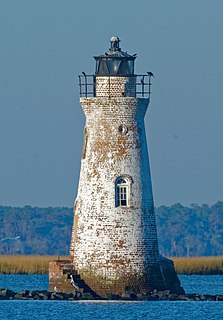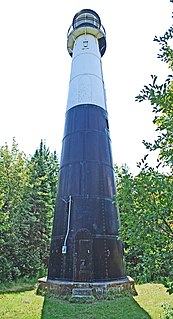
Cabrillo National Monument is at the southern tip of the Point Loma Peninsula in San Diego, California, United States. It commemorates the landing of Juan Rodríguez Cabrillo at San Diego Bay on September 28, 1542. This event marked the first time a European expedition had set foot on what later became the West Coast of the United States. The site was designated as California Historical Landmark #56 in 1932. As with all historical units of the National Park Service, Cabrillo was listed on the National Register of Historic Places on October 15, 1966.

The Gasparilla Island Lights are on Gasparilla Island in Boca Grande, Florida. The Port Boca Grande Lighthouse is on the southern tip of Gasparilla Island, and marked the Boca Grande Pass entrance to Charlotte Harbor.

The Cockspur Island Light is the smallest lighthouse in Georgia. It ceased operation as an active beacon in 1909. It has been relit since 2007 for historical rather than navigational purposes.

The Pensacola Light is a lighthouse at Pensacola Bay, in Florida. It is the third iteration of what was originally a lightship, the Aurora Borealis, and remains an aid to navigation.

The St. Joseph Point Light was a lighthouse on the mainland north of present-day Port St. Joe, Florida, across the entrance to St. Joseph Bay from St. Joseph Point. St. Joseph Bay is enclosed by St. Joseph Peninsula, which runs west some three miles (5 km) from the mainland to Cape San Blas, and then northerly 15 miles (24 km) to St. Joseph Point. An earlier light in the area was the St. Joseph Bay Light.

Boston Light is a lighthouse located on Little Brewster Island in outer Boston Harbor, Massachusetts. The first lighthouse to be built on the site dates back to 1716, and was the first lighthouse to be built in what is now the United States. The current lighthouse dates from 1783, is the second oldest working lighthouse in the United States, and is the only lighthouse to still be actively staffed by the United States Coast Guard, being automated in 1998 though there is still a keeper acting as tour guide. The structure was designated a National Historic Landmark in 1964.

Morris Island Light is a lighthouse on Morris Island in South Carolina. The light stands on the southern side of the entrance to Charleston Harbor, north of the City of Folly Beach. At 161 ft, it is the tallest lighthouse in South Carolina. The lighthouse was named to the National Register of Historic Places in 1982.

The first Saginaw River lighthouse was constructed from 1839 to 1841, in a period when large quantities of lumber were being harvested and shipped from the heart of Michigan via river and the Great Lakes to the East Coast of the United States via the Erie Canal and Hudson River. This connection to major eastern markets was critical to the development of central Michigan.

Marcus Hook Range Rear Light is a lighthouse near Bellefonte, Delaware marking a range on the Delaware River. It is the highest light on the Atlantic coast of the United States. The lighthouse is visible on the horizon from the windows of high-rise buildings in downtown Wilmington, Delaware.

The Staten Island Range Light, also known as the Ambrose Channel Range Light, is the rear range light companion to the West Bank Lighthouse. Built in 1912, the 90-foot tower sits more than five miles northwest of the West Bank Lighthouse, on Staten Island’s Richmond Hill, 141 feet above sea level. It shows a fixed white light that can be seen for 18 miles, by all vessels bound to New York and New Jersey Ports coming in from the Atlantic Ocean.

The Newburyport Harbor Front Range Light is one of two historic range lights in Newburyport, Massachusetts. When it was built in 1873, it was located at Bayley's Wharf, and provided, in combination with the Rear Range Light, a critical aid for navigating into Newburyport's harbor. In 1964 the light was moved to its present location on the grounds of the Merrimack River Coast Guard Station. The stations are no longer in service, but serves as a daymark for arriving mariners.

The Newburyport Harbor Rear Range Light is a historic lighthouse at 61½ Water St. near the Merrimack River in Newburyport, Massachusetts. It was built in 1873 as one of a pair of range lights for guiding ships up the river to the city's harbor.

The Fort Sumter Range Lights are range lights to guide ships through the main channel of the Charleston Harbor, South Carolina. The original front light was built at Fort Sumter and the original rear light was in the steeple of St. Philip's Church in Charleston, South Carolina. Both lights were lit from 1893 to 1915 to make range lights. Today the Fort Sumter Range is the main approach channel to Charleston Harbor.

The Grand Island Harbor Rear Range Light is a lighthouse located off M-28 in Munising Township, Michigan. It is also known as the Bay Furnace Rear Range Light, Christmas Rear Range Light, or End of the Road Light. The corresponding front range light was replaced in 1968; the rear range light was listed on the National Register of Historic Places in 1990. It is no longer an active aid to navigation.

Rawley Point Light is a lighthouse located in Point Beach State Forest, near Two Rivers, Wisconsin. At 111 feet (34 m) tall, it is the tallest lighthouse on the Wisconsin Shore and it is listed on the National Register of Historic Places.

The South Fox Island Light was a light station located on South Fox Island in the north end of Lake Michigan. There are two towers standing at the site: the first is the original brick keeper's house and tower, while the second is a skeletal tower moved to this site from Sapelo Island, Georgia in 1934. Neither is operational. The station was listed on the National Register of Historic Places in 2021.

The St. Joseph North Pier Inner and Outer Lights are lighthouses in Michigan at the entrance to the St. Joseph River on Lake Michigan. The station was built in 1832 with the current lights built in 1906 and 1907; they were decommissioned in 2005.

The Nathanael Greene Monument is a public monument in Savannah, Georgia, United States. Located in Johnson Square, the monument was designed by William Strickland and honors Nathanael Greene, a general in the Continental Army during the American Revolutionary War. While the cornerstone was laid in 1825, the monument was not completed until 1830, at which time it served as a joint monument for Greene and fellow Continental Army general Casimir Pulaski. The monument became solely dedicated to Greene in 1853, after which two bronze plaques honoring Greene were added to the structure. In 1902, Greene's body was reinterred under the monument. In 2018, one of the bronze plaques was vandalized with googly eyes, which drew national attention to the monument.

Emmet Park is an urban park in Savannah, Georgia, United States. It is located in the northeastern corner of the city's historic downtown area, in what was known as the Old Fort neighborhood. It is bounded by Rossiter Place to the north and East Bay Street to the south, and is about 300 feet (91 m) from the Savannah River's southern banks.




















